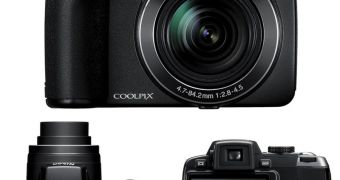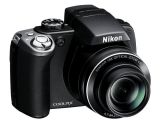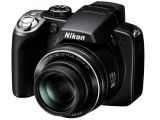Nikon's D3 and D300 digital single lens reflex cameras (or DSLRs, as most people know them) have reinforced the company's position on this market and for the first time since...well, since a long time ago, Canon photographers have begun to jump ship.
Unfortunately, while Nikon's DSLRs are selling like hot cakes, its bridge models are not nearly as popular as those from Fujifilm, Canon and Olympus. This might change, however, since Nikon has just announced the Coolpix P80, an advanced camera packed with features.
The new model is powered by a 10.1 megapixel sensor and comes with a VR-stabilized 18x optical zoom lens yielding a picture angle equivalent to that of a 27-486mm unit in terms of 35mm. Unfortunately, all those megapixels are crowded on a relatively small 1/2.3-inch imaging unit, which is bound to yield noisy images, even at low ISO settings. For a bit of history, the older and discontinued Coolpix 8800 had a 2/3-inch CCD (8.8 by 6.6 millimeters) with 8 million pixels; this one has a 1/2.3-inch CCD (7.7 by 6.16 millimeters) with 10.1 megapixels. Not extremely encouraging, but let's not bash Nikon for this. After all, it's not the only manufacturer with the "tiny sensor with lots of megapixels" strategy.
On the bright side of things, the 18x optical zoom lens is particularly fast as it can go to f/2.8 at the widest end and f/4.5 at the longest end. In more simple terms, it means that the camera does a better job in low-lit spaces and that it can yield slightly shallower depths of field (but not by much). Compared to the top-shelf Fujifilm FinePix S100fs 14.3x Fujinon lens with a maximum aperture ranging from f/2.8 to f/5.3, one can say that the Nikon engineers' achievement is praiseworthy.
ISO sensitivity ranges from 64 to an impressive, albeit totally useless 6400 (only for 3-megapixel resolution or less). A standard auto mode adjusts the sensitivity from ISO 60 to ISO 800, a high-sensitivity mode goes up to 1600, but there's also a choice called "fixed range auto" from ISO 64 to ISO 400. Since cameras with tiny sensors are not particularly ecstatic when pushing the ISO to high values, the fixed range auto seems to be best choice for decent-looking images.
Apart from the P, A, S, M modes that can be set with the main dial sitting on the top-side of the camera, the P80 also features a high-speed continuous shooting mode that grants photographers speeds of 13 frames per second in burst of 30 (note that this feature only works for images with resolutions of 3 megapixels or lower). Other useful features include improved face-priority AF, in-camera red-eye fix and the D-Lighting technology.
In terms of image composing and reviewing, apart from the classic electronic viewfinder, the P80 also sports a generous 2.7-inch monitor with anti-reflection, 230k-dots of high resolution and wide viewing angle.
The new model records JPEG, AVI and WAV formats, but the RAW option appears to be missing; a major drawback in Nikon's struggle against Fujifilm and Olympus.
All in all, the Coolpix P80, available with a MSRP of $399.95 beginning April 2008, seems to have what it takes (with some exceptions) to go against the heavyweights of this class, but only thorough reviewing will provide useful information on which camera is better.

 14 DAY TRIAL //
14 DAY TRIAL // 

